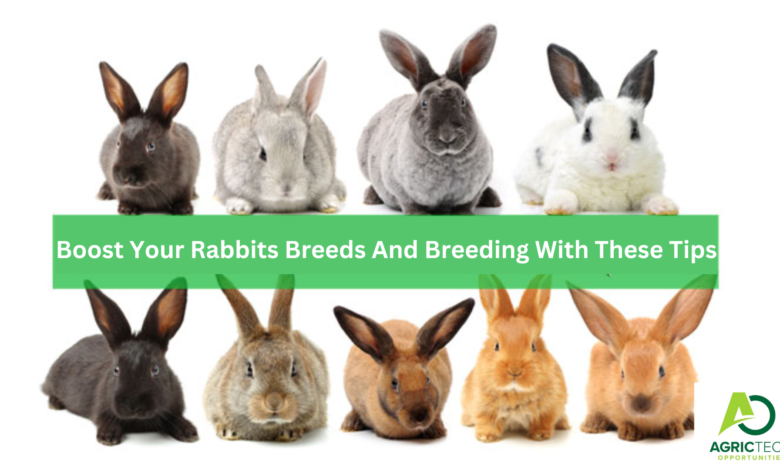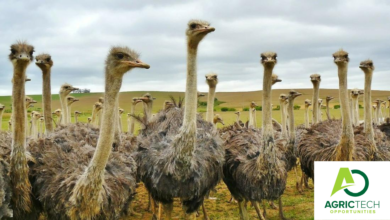Boost Your Rabbits Breeds And Breeding With These Tips 2023

Host Country
GLOBAL
Target Audience
RABBIT FARMERS
Program Overview
Many different breeds of rabbits are available; common differences between breeds include size, color, and length of fur.As pets, they need a cosiderable amount of care and attention.Rabbits are small mammals in the family Leporidae.
The European, or Old World, rabbit (Oryctolagus cuniculus) is the only genus of domestic rabbits. In this article we will be focusing on rabbits breeds and breeding in order to maximize rabbit production efficiently.
Rabbits are Classification by size
•As adults, rabbits may be classified as giants, standard or small
•Small rabbits weigh about 1.4-1.8 kg at maturity
•medium breeds 4.1-5.4 kg
•Large breeds 6.4-7.3 kg
ALSO READ: How To Easily Perform Artificial Insemination Technique (AI) In Various Species Of Farm Animals
Classification by body type:
1.Commercial: based on ideal body for meat production; larger with body depth equalling width; showing a smooth round curve at the back and hindquarters; e.g., Californian, New Zealand
2.Full arch – rabbits in this category naturally pose up on their toes and show a smooth arch from the neck of the neck through the shoulders loin and hip to the tail; e.g., Belgian Hare, English Spot
3.Semi arch – This type sits with legs flat on the table and the arch begins at the back of the shoulders; e.g., Flemish Giant, Giant Chinchilla
4.Compact – most fancy breeds are small, light, short in length and compact; e.g., Dutch, English Angora
5.Cylindrical – long, thin tube shaped body with fine bone and a slender head; posed in a stretched out position e.g., Himalayan
Classification by use:
1.Meat or Dual purpose Breeds
•pelts + meat
•good growth traits, white fur preferred by processors
•Chinchilla Giganta, New Zealand and Californian
ALSO READ: The Ultimate Guide To Rabbit Production- WHY KEEP RABBITS
2.Fancy breeds
•have distinct markings and laid down characteristics; bred mainly for show purposes;
•Californian types
3.Wool-bearing rabbits
•They are bred for wool/fur production
•fur markets are unstable and unreliable
•Angora and Rex breeds, can produce wool of about 5-8 cm long
4.Hybrids
•generally used for meat production due to high growth rates, good food conversion ratio and high meat to bone ratio
•Mature mass of 3-5 kg
Rabbit breeds in Africa

Flemish Giant:
Flemish Giant is a semi-arch type rabbit with a steel grey or fawn coloured body, white belly and dark eyes. Mature weight is 5.0-5.5kg.

New Zealand White:
This breed is used most widely throughout the world for meat production. It is all white in colour with pink eyes, medium length body, short-set legs and dense coat; and usually weighs 4.5-5.5kg when mature. Meat is whiter than that of other breeds

New Zealand Red:
This is essentially red or reddish gold/brown with pink eyes; has not been intensively selected for growth rate. Mature live weight is 3-4.5kg.

Chinchilla:
This breed can be described as wild agouti (blue-grey in colour), followed by pearl grey with brown on the fur and dark eyes. There is a thick fold of skin around the front of the chest which is very obvious when the rabbit is in good condition and sitting in a resting position. The weight range for the mature Giant Chinchilla is 4.5-5.0kg

Californian:
This is the second most popular breed for meat production. The colour is all white but with black tipping on the nose, ears, feet and tail. Has dense fur. The weight range for the mature Californian is 3-4.5kg.

•Zika: Darker wild agouti or white fur and dark eyes. Lower fertility than other breeds. Mature weight 5-5.5kg
ALSO READ: Top Principles Of Pig Nutrition For 2023/24
| Commercial rabbit breeds | ||
| Breeds | Size | Use |
| Angora | medium | wool; meat |
| American Chinchilla | medium | fur |
| Californian | medium | meat |
| Champagne d’Argent | medium | meat |
| Checkered Giants | large | fur |
| Dutch | small | lab |
| English Spot | medium | meat; lab |
| Flemish Giants | large | meat |
| Himalayan | small | lab |
| New Zealand | medium | meat |
| Polish | small | lab |
| Rex | medium | fur |
| Silver Martens | medium | fur |
Selection of stock
Breeding stock is selected predominantly from past own performance records or those of its parents for these quantitative traits
•Fertility, breeding efficiency, reproductive efficiency
•Growth and feed efficiency
•Milk production
•Disease resistance, mortality
•Carcass quality
•Type and conformation
•Longevity
•Health and vigour
•High heritability for most of these traits.
•Selecting on the basis of coat or eye colour is secondary
ALSO READ: Approved Principles Of Poultry Production For 2023/24
Selecting a breed
•Large breeds (6.4-7.3kg) are sometimes used for meat, but have a lower FCR than medium breeds
•Small breeds (1.4-1.8 kg) are used primarily for pets, shows and hobbies
•Medium breeds that are considered dual purpose and most commonly used for meat and research laboratories
•New Zealand White and Californian, which are the most popular medium breeds, reach a weight of 1.4 to 2.3 kg in 8 weeks of age or less
Traits of economic importance
•Prolificacy – influences the potential for multiplication of the rabbits. This is determined by litter size, pre-weaning mortality, litters per year, age at first mating, reproductive life and age at culling
•Growth – measured by weaning weights, pre and post weaning daily gain, mature weight, and feed conversion efficiency. Good FCE ensures high animal productivity.
•Meat to bone ratio – must be high enough to produce high meat yielding carcasses
•Loin development – must be good and this is usually found in rabbits with a short and compact body.
•Dressing out percentage – at 13 weeks is about 60-63%
For Any questions about rabbit breeds and breeding production leave in the comment section below.
Thank You
ALSO READ: The Benefits of Doing an Internship: How It Can Help You Get Ahead in Your Career
For more updates On Agric Tech Opportunities kindly join the social groups below:
Join our Telegram | Follow us on Linkedin | Also, Follow us on Twitter. | Join Our Whatsapp Group
God bless and All the best !!




